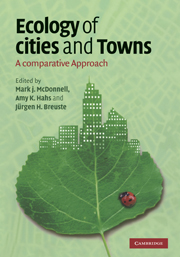Book contents
- Frontmatter
- Contents
- List of contributors
- Preface
- 1 Introduction: Scope of the book and need for developing a comparative approach to the ecological study of cities and towns
- Part I Opportunities and challenges of conducting comparative studies
- Part II Ecological studies of cities and towns
- 8 Responses of faunal assemblages to urbanisation: global research paradigms and an avian case study
- 9 Effect of urban structures on diversity of marine species
- 10 Comparative studies of terrestrial vertebrates in urban areas
- 11 The ecology of roads in urban and urbanising landscapes
- 12 Spatial pattern and process in urban animal communities
- 13 Invertebrate biodiversity in urban landscapes: assessing remnant habitat and its restoration
- 14 Arthropods in urban ecosystems: community patterns as functions of anthropogenic land use
- 15 Light pollution and the impact of artificial night lighting on insects
- 16 A comparison of vegetation cover in Beijing and Shanghai: a remote sensing approach
- 17 Vegetation composition and structure of forest patches along urban–rural gradients
- 18 Environmental, social and spatial determinants of urban arboreal character in Auckland, New Zealand
- 19 Carbon and nitrogen cycling in soils of remnant forests along urban–rural gradients: case studies in the New York metropolitan area and Louisville, Kentucky
- 20 Investigative approaches to urban biogeochemical cycles: New York metropolitan area and Baltimore as case studies
- Part III Integrating science with management and planning
- Part IV Comments and synthesis
- References
- Index
- Plate section
12 - Spatial pattern and process in urban animal communities
Published online by Cambridge University Press: 04 March 2010
- Frontmatter
- Contents
- List of contributors
- Preface
- 1 Introduction: Scope of the book and need for developing a comparative approach to the ecological study of cities and towns
- Part I Opportunities and challenges of conducting comparative studies
- Part II Ecological studies of cities and towns
- 8 Responses of faunal assemblages to urbanisation: global research paradigms and an avian case study
- 9 Effect of urban structures on diversity of marine species
- 10 Comparative studies of terrestrial vertebrates in urban areas
- 11 The ecology of roads in urban and urbanising landscapes
- 12 Spatial pattern and process in urban animal communities
- 13 Invertebrate biodiversity in urban landscapes: assessing remnant habitat and its restoration
- 14 Arthropods in urban ecosystems: community patterns as functions of anthropogenic land use
- 15 Light pollution and the impact of artificial night lighting on insects
- 16 A comparison of vegetation cover in Beijing and Shanghai: a remote sensing approach
- 17 Vegetation composition and structure of forest patches along urban–rural gradients
- 18 Environmental, social and spatial determinants of urban arboreal character in Auckland, New Zealand
- 19 Carbon and nitrogen cycling in soils of remnant forests along urban–rural gradients: case studies in the New York metropolitan area and Louisville, Kentucky
- 20 Investigative approaches to urban biogeochemical cycles: New York metropolitan area and Baltimore as case studies
- Part III Integrating science with management and planning
- Part IV Comments and synthesis
- References
- Index
- Plate section
Summary
Introduction
Urbanisation provides an environmental gradient from a highly developed core to a rural or natural area (Numata,1976; McDonnell and Pickett, 1990). Urban–rural gradients provide a useful laboratory in which to examine environmental effects on communities. Analysing changes in a biological community along such a gradient provides a scientific basis for planning ecological cities, but also makes it easier to test hypotheses through management of urban landscapes.
Urban ecosystem studies in Japan started in 1971 as a part of a project on ‘human survival and environment’ (Numata, 1976). Numata defined an urban ecosystem as one consisting of man-modified and man-made ecosystems, and he proposed three approaches to urban ecosystems: (1) examining the flow of energy, matter, people and information; (2) studying the impact of an urban environment on terrestrial and aquatic ecosystems; and (3) studying reactions to the abiotic environment (in the Clementian sense). He and his colleagues reported a series of urban ecological studies of metropolitan Tokyo (see Numata, 1982).
Although urban ecological study in Japan covers many fields, such as pollution of air and water, urban climates and the water cycle, one important subject is the impact of urbanisation on flora, fauna and the biological community. Early studies focused on biological indicators of urbanisation; lichen (Taoda, 1973), alien plants (Hotta, 1977), soil arthropods (Aoki, 1979), and the retreat of wild animals (Chiba, 1973) were used as indicators. Through comprehensive study of urban ecology, Numata (1987) identified the importance of landscape ecology in urban ecosystem studies.
- Type
- Chapter
- Information
- Ecology of Cities and TownsA Comparative Approach, pp. 197 - 214Publisher: Cambridge University PressPrint publication year: 2009
- 4
- Cited by

